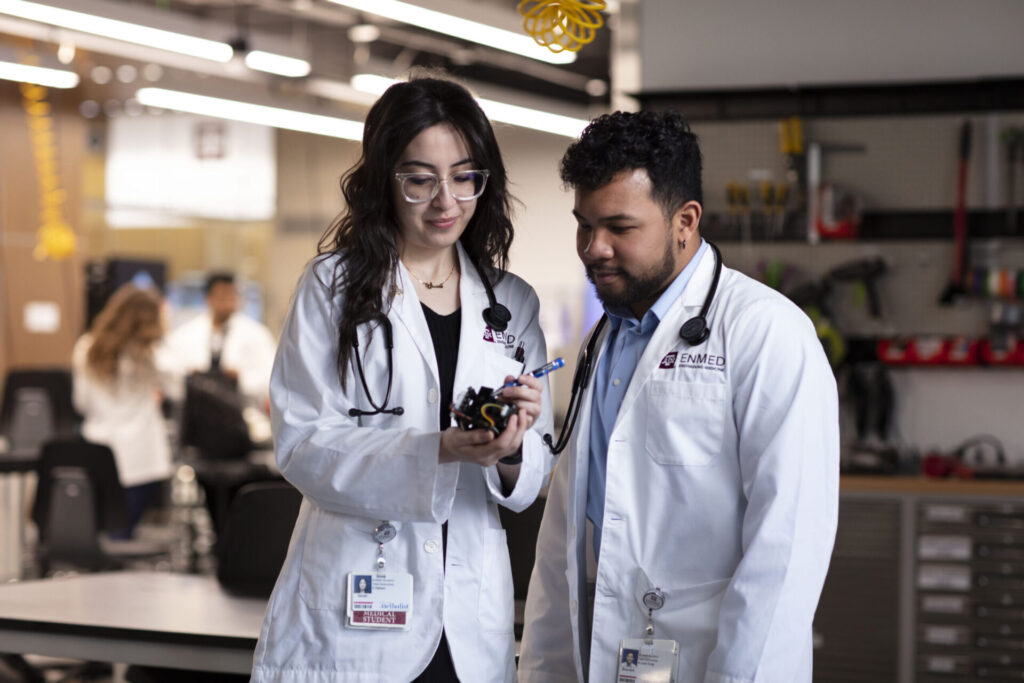
Uniquely equipped to address and problem solve health care’s greatest challenges, Sarah Hakam and Brandon Look Fong, two first-year EnMed students, each discovered anatomical variations during routine donor dissections. Their findings landed them a spot at the Anatomy Connected 2023 conference of the American Association for Anatomy (AAA). In just their first year of medical school, Hakam and Look Fong are breaking ground in the world of medicine.
During their Medical Gross Anatomy (MGA) class, a course taught to first-year EnMed medical students, Hakam, Look Fong and their groups were tasked to perform routine dissections on human body donors by body region. During
their dissections, for something that seemed normal to the average eye, the students noticed something different.
In the dissection Hakam and her group were performing, they identified a duplication of the left ureter in a 78-year-old caucasian male donor. Humans are born with two ureters, one connected to each kidney; however, their group discovered two ureters coming from the left kidney, one from the top and the other from the bottom, that merged and entered the bladder together. Hakam emphasized that “While it is a rare find, it is important for doctors to be aware and take note of because during operations, if the other ureter is damaged, it can be extremely harmful to the patient.”
During Look Fong’s gastrointestinal dissection, his group discovered a bilateral variation in the arrangement of renal vessels at the renal hilum in a 72-year-old caucasian male donor. This signified that the renal artery went over the renal vein, being compressed on both sides. “In the body, arteries are tough, whereas veins are softer, so the veins lay atop arteries, so that they aren’t squished. When we found it to be backwards in the donor, we knew that it was an abnormal presentation of the renal artery,” said Look Fong.
The students took their findings to EnMed’s anatomy instructors and the students’ trusted mentors, Leslie Day, PhD, and Rhome Hughes, MD, to explore the next steps of their medical discoveries. With their guidance and encouragement from their mentors and peer authors, the students felt more than confident to draft medical abstracts for AAA submission. “Dr. Day and Dr. Hughes went above and beyond and really drove home the idea of self-learning and self-exploring, smooth lining the entire process for us to succeed,” said Look Fong. As the students express an abundance of adoration for their instructors, their instructors do the same. “Sarah and Brandon found the abnormalities and studied them thoroughly; they put in all of the hard work—all we did was help them take the next step,” said Day.
Feeling prepared and encouraged by both their mentors and their student groups, Hakam and Look Fong headed to Washington, D.C. on March 25 to present each of their medical abstracts at the Anatomy Connected 2023 conference. From poster presentations and exhibits to networking sessions and workshops, the students had the opportunity to experience the conference with accomplished and well-known leaders in health care. “It was both of our first medical school conferences. We were able to make connections that we learned in MGA and see them unfold and play out in day-to-day life. It was really cool to see!” expressed Hakam.
Even as the conference came to a close on March 27, the students did not stop there. Continuing to work alongside each other, Day, Hughes, Hakam and Look Fong are taking their abstracts to the next level and both writing their first publication. Congratulations to Hakam and Look Fong on this groundbreaking accomplishment! EnMed is excited to see the next challenges these outstanding students conquer next.